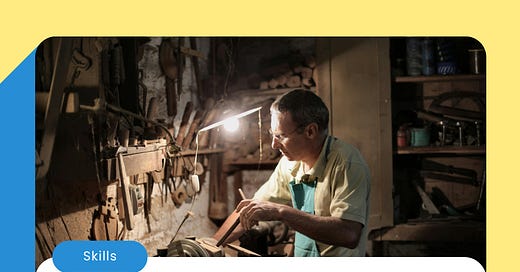How do you make decisions?
Or better yet, how do you know you’ve made the right decision?
You would probably slap yourself for some of your decisions. Ordered sushi to live healthier but now craving pizza? Hired a colleague who ticked all the boxes over a friendly one and now you regret it?
You could be Lucky Luke and make good decisions most of the time. But you don’t have to rely on luck. Sharpen your decision-making skills. We start today.
Making decisions: lottery or intention
You make millions of decisions every day—what time to get up, what to wear, which road to take to work, how to greet your receptionist, etc.
Sometimes, you follow the flow and see if you hit the lottery.
A: “Wanna join us for lunch? We’ll be going to the Indian place.”
B: (Not feeling like eating Indian, but having no other ideas) “Okay.” Later that day, you feel pretty happy and well-energized from the food.
Other times, you work hard to make a decision. You list the pros and cons and decide on a better option.
Yet, logical decisions are deceptive beasts. What seems like a good option might turn out differently (you wanted a promotion but then missed your old tasks—ouch).
Likewise, decisions made on a whim do not always pay off. So, we are always left with some good and some bad decisions. They happen, no matter how hard you try to make everything right.
Your team does not like to hear that. They prefer you to be the one who decides well most of the time. You’re a leader they follow and trust.
Well, no. Decisions are often a lottery.
Do it or don’t it and wait.
When you don’t know, do you tend to do nothing, hoping the situation will solve itself?
Waiting and hiding is an avoidance strategy many use to cope with difficult decisions. The truth is, they won’t be happy about it. Passivity takes away the achievement and dialogue.
Waiting is the worst thing you can do when facing a difficult choice. I don’t mean waiting because you are patient, but waiting because you’re paralyzed or don’t want to make a tough call. You know you should do it, but you’re waiting as if something might change.
Simply:
Waiting for patience = good.
Waiting for avoidance = bad.
Sharpen your decision-making skills
Roll up your sleeves. Get ready. Prime yourself. Give it your best shot.
Okay. The question remains: “How should you decide better or more efficiently?”
Use these 3 strategies:
1. Follow your first thought
You hear an idea, and you immediately say to yourself: “Hell, no"!”
System 1: Intuition & instinct - unconscious, fast, emotional, automatic pilot
System 2: Rational thinking - takes effort, slow, logical, indecisive

Your thinking process plays with both rational and non-rational motivations and triggers. Sometimes you decide quickly, but then you have second thoughts.
Experiment by following your first idea this week. Trusting your intuition might seem like cheesy advice, but System 1 is crucial for our survival and useful at work.
Disagree when you disagree. Give a second chance when you feel it’s right. Accept the offer.
Rational thinking can hook you into days of consideration. Should you? Shouldn’t you? Being conscious is important, but it shouldn’t lead to a complete mental block that stops you from moving forward. Progress, even if slow, is key.
2. One thing at the time
My friend Elizabeth Ng uses a cake metaphor for problem-solving. Imagine your decisions are a cake.
Every day, you have new problems and decisions to make. So, every day, you have a new cake. You decide how big the pieces will be, where you put your energy, and how you frame them (big problem = big stress, or maybe not?).
Slice your troubles.
Focus on one decision at a time. Like a cake, you eat it bit by bit. When you have millions of decisions to make, take them one by one. Annoying client? Deal with them first. Checking a report? Book an hour in the afternoon to go through it.
Organize yourself around each decision. Multitasking in decision-making is total nonsense because it leads to chaotic outcomes.

Enjoy your cake!
3. Be critical
Blue or red pill?

Gather relevant information. Make a list of pros and cons, conduct a SWOT, create a decision tree, and list your priorities.
When you sit in front of data and information, question the validity of the assumptions underlying your options.
Red or blue? Challenge your biases and beliefs, and consider not just one but all options.
What happens if you take the red one?
What happens if you don’t take the red one?
What happens if you take the blue one?
What happens if you don’t take the blue one?
Can you take both?
Why can’t you take both?
Questions, my dear friend, are sharpening your decisions. Questions make you think, consider, and reflect.
Your past decisions will push through, telling you: “Do this, like last time.” Question your experience and learn from the past. Be critical.
Lastly, gather your thoughts and share them with someone. They will tell you how you sound, which might be your eye-opening moment.
TL;DR
Don’t waste time:
Trust your gut. Sometimes, your first thought is the best one. Don’t always overcomplicate every decision.
Slice and enjoy the cake. Mnam! Don’t try to eat the whole cake at once. Focus on one decision at a time.
Channel your inner Neo aka be a critical thinker. When making decisions, gather all the information you can and question everything. The blue or the red? Not an easy decision.
Let’s go to work now! Ciao, Ivona
Monday Deep Dive: Wellbeing at work
Thursday Newsletter: Leadership news






